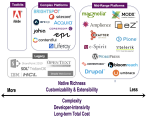What's next for the mobile Internet in India
Last week, I attended two conferences in Delhi. Coincidentally, both of them were on similar topics. The first one, organized by Indian trade body, NASSCOM was about mobile Internet and appstores, while the second one was about mobile applications (although it ended up as a conference for sales pitches by device vendors).
India recently finalized its 3G policy and although we are way behind many countries, it is expected that 3G subscribers will cross the 100 million mark - that's more than the total population of many countries - within 5 years. With one of the lowest rates in the world (20 paise a minute or about 0.5 cents for a 3G video call) and innovations such as the $35 tablet, I don't doubt that estimate at all. 3G will reach where wired broadband could not.
What concerns me though are some of the other challenges that remain largely unaddressed:
- I don't think the content providers and app developers have understood local pricing yet. Many of them have their global pricing strucutures applicable here. In fact, many of them have actually priced their offerings higher in India. I am no economist but I also understand that the incremental cost of producing a digital product is miniscule as compared to that of a physical product. A small blog post is not enough to discuss all the intricacies of pricing but the content providers (and also the vendors) should keep their options open for differential pricing as well as pricing which is in line with cost of other things. After all, a customer who pays 0.5 Cents for a 3G video call is hardly likely to pay $20 for a social networking client
- It is just not sufficient to have iPhone or Blackberry versions of your site if you want your content to be consumed more broadly. You need to be able to have much more fine-grained support for different types of handsets, and not just a few types of smart-phones. We detail why this is important and how this can be implemented in an advisory paper, "Adapting Your Content Management Platform for Mobile Delivery" for our subscribers.
- Localization is very important. There are 22 official languages and many more dialects as well as unofficial languages spoken in India. So your content systems should make it easier for users to interact in local languages. Having a Unicode compliant WCM system is not enough; you also need to have local language interfaces to enter content in users' language of choice. I'm not suggesting that there should be a version of TweetDeck in all 22 languages, but you get the idea.
- Apart from the language, there are many other unique aspects that these systems should support or enable. As an example, if some of the vendors were to come up with an out-of-the-box accelerator for building Matrimony or Astrology sites -- the two most popular type of web content in India -- I am sure they would have a big customer base
- And finally, for app developers, there is a serious lack of support in terms of SDKs, APIs, policies, and documentation for them to be able to create language-specific, localized applications. As an example, some app stores do not allow you to submit applications that are ad supported. So you can only submit apps that are either free or paid but not that are supported by any alternative business model. If someone wants to develop a highly unique application such as the one that allows tobacco farmers in rural India to participate in tobacco auctions, the only way to make money would be by way of ads (example courtesy @pranshuj)
In one of the conference keynotes, a speaker explained how mobile apps are going to be big. He gave his own example of how he starts his day by checking his Facebook account, prepares for a music concert, books movie tickets, and does a lot of other stuff all using his "smart" handset. While I don't subscribe to this hype - in this case, our friend probably doesn't have a laptop or life - I do believe that there is a huge opportunity waiting to be tapped, and some of these challenges will need to get addressed sooner than later.








